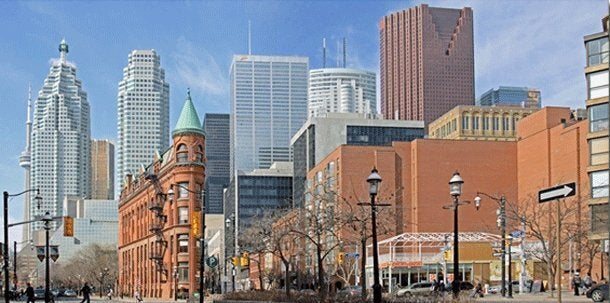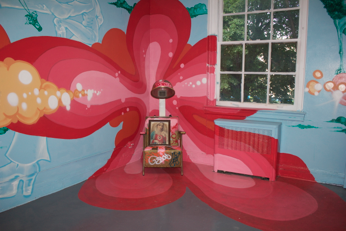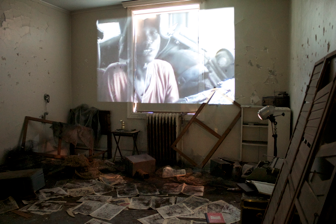
I first encountered No Longer Empty in Howard Hurst's Hyperallergic article from early May. Intrigued by the seemingly impossible partnership between "pop-up" exhibition-making and community building, I sought out Executive Director Naomi Hersson-Ringskog to inquire further into the nonprofit, beyond what could be found on their website.
 Daze, Furthur (2012)
Daze, Furthur (2012)
Given its nomadic nature, weaving in and out of neighborhoods and communities throughout New York City, the No Longer Empty team inhabits the space in which each project is produced, which is precisely the reason Ms. Hersson-Ringskog and I met at the Bronx's own Andrew Freedman Home -- a place for old folks who'd lost their fortunes to sustain their lavish lifestyles -- and the setting for NLE's current exhibition, This Side of Paradise.
Upon entering the grand Home, I was greeted warmly by curatorial volunteer, Lucy Lydon (a gesture apparently foreign to many galleries and museums here in New York). I floated through the bottom two galleries, primarily visiting with Mel Chin's S.O.S. Reloaded: Bronx piece -- video shots of Bronx residents, their personal messages to President Obama tickering across the bottom of the screen, while heartbeats compose a rhythmic soundtrack.
I quickly noticed synergies running through the exhibition. Each site-specific work speaks individually yet collectively to themes of nostalgia for a no longer existent past through representations of the present; histories and remembrances of the Home; the social, political, and cultural significance of the Bronx; and the illumination of a space within a community.
Soon after my time spent on the bottom floor of the show, Ms. Hersson-Ringskog and I claimed a section of grass on the front lawn of the mansion and discussed NLE's process and challenge of building professional exhibitions, while remaining grounded within community.
Each project begins with extensive, organic research, partnering with local community organizations, community boards, and business improvement districts, to name a few. "The exhibitions are a way of paying homage to the site and to the neighborhood," Hersson-Ringskog explained.
 Tim Hetherington, Diary (2010)
Tim Hetherington, Diary (2010)
Not unlike other projects NLE has completed in the past, This Side of Paradise represents a mechanism for cultural tourism and encourages further exploration into local cultural centers and neighborhood businesses in the Bronx. At the information desk of the Andrew Freedman Home, you will find a brochure described as "a cultural map of places, people & curious histories." Inside is a detailed map of the Bronx, identifying destinations such as, Bronx Art Space, Longwood Arts Project/Gallery at Hostos Community College, and Bronx Music Heritage Center; while marking the "stomping grounds" of well known people, like Grandmaster Flash, Edgar Allen Poe, and Collin Powell.
Alongside their exhibitions, the NLE team collaborates with local groups and people to produce programs that speak to the themes of each exhibition and the environments in which they live. "It's about activating the site," Hersson-Ringskog said when I asked about the programs. While in partnership with The Bronx Arts Alliance and collaborating with groups including The POINT and the Bronx River Art Center, the list of programs for This Side of Paradise has grown organically throughout the course of the exhibition and helped establish what Hersson-Ringskog calls, "inroads with the community."
Perhaps the most impressive characteristic of this three-year old nonprofit is its pervasive consistency in regards to its mission and vision. From its free admission and open-door policy, to its desire to gather community participation and visitor response, No Longer Empty remains an innovative cultural organism in which creative practice, professional curation, and community vitality are fused and enriched within the diverse neighborhoods of New York City.
In this downtrodden economy in which the arts are often seen as superfluous and secondary, it is inspiring to see a young arts organization thriving and actively changing the ways in which people engage with nomadic art making and acknowledge the spaces and places in which art is created and shared.
 Adam Parker Smith. I Lost All My Money in the Great Depression and All I Got Was This Room (2012)
Adam Parker Smith. I Lost All My Money in the Great Depression and All I Got Was This Room (2012)
On the subway ride downtown I shared a seat with Lisa Kahane, This Side of Paradise contributing artist and principle photographer of the one and only Fashion Moda. She was kind enough to share her experience in the exhibition. "Working with the team at No Longer Empty is easy," Kahane says. "The women I work with -- Manon, Naomi, Jodie, Charlotte and Lucy -- are unfailingly supportive and patient, even under duress, working overtime to make things happen. When new situations come up during the show, they incorporate them into the whole. Most importantly, everyone understands that the interplay between art and context increases meaning."
Having photographed the Bronx since 1979, Kahane has seen and documented the rapid changes the borough has endured over time. Kahane's living project for This Side of Paradise includes a "traveling portrait studio" and visual documentation of the space, people, and community engaging with the exhibition. You can find her in Room 248 in the old home, and depending on the circumstance she may even take your picture.
This Side of Paradise will be open to the public until June 6. Don't miss your chance to experience a visual labyrinth where original works of art speak to the histories, architecture, and people of a given space.
All Photos courtesy of Tina Orlandini